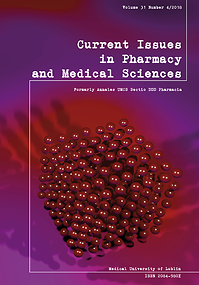Assessment of Concentration Changes of Selected Elements in Birch Sap, Depending on Collection Day, Using Atomic Absorption Spectrometry
DOI:
https://doi.org/10.1515/cipms-2018-0012Keywords:
birch sap, atomic absorption spectrometry, mineralsAbstract
Research on new products made of naturally occurring substances that possess regenerative and recuperative characteristics of benefit to humanity occurs continuously. In light of this, birch sap is receiving more and more attention. The aim of this work was an assessment of concentration changes of selected elements in birch sap depending on the day of collection. Herein, we utilized a ContrAA 700 high-resolution atomic absorption spectrometer with continuous light source (HR-CS-AAS) and we applied electro-thermal and flame techniques. Our results indicate that the concentration of the marked elements is variable and is connected with the date of collection. For most of elements, a downward trend can be observed. Only the amount of iron increased with time.
References
1. Strzelecka H. Encyklopedia zielarstwa i ziołolecznictwa. Warszawa: Wydawnictwo Naukowe PWN;2000:72-73.
2. Gertig H, Przysławski J. Bromatologia, zarys nauki o żywności i żywieniu. Warszawa: PZWL;2006:177-237.
3. Bilek M, Natłok N, Kaniuczak J, Gorzelany J. Sugar and inorganic anions content in mineral and spring water-based beverages. Rocz Państw Zakł Hig. 2014;65(3):193-197.
4. Ostrowska A, Gawliński S, Szczubiałka Z. Metody Analizy i oceny właściwości gleb i roślin. Warszawa: Instytut Ochrony Środowiska;1991:36.
5. Łuczaj Ł, Bilek M, Stawarczyk K. Sugar content in the sap of birches, hornbeams and maples in southeastern Poland. Cent Eur J Biol. 2014;9(4):410-416.10.2478/s11535-013-0284-8
6. Bilek M, Stawarczyk K, Łuczaj Ł, Cieślik E. Zawartość wybranych składników mineralnych i anionów nieorganicznych w sokach drzewnych z terenu podkarpacia. Żywność. Nauka. Technologia. Jakość. 2015;3(100):138-147.
7. Bilek M, Siembida A, Stawarczyk K, Cieślik E. Aktywność przeciwrodnikowa soków drzewnych z terenu Podkarpacia. Żywność. Nauka. Technologia. Jakość. 2015;4(101):151-161.
8. Bilek M, Stawarczyk K, Siembida A, Strzemski M, Olszewski M, Cieślik E. Zawartość cukrów w sokach drzewnych z terenu Podkarpacia. Żywność. Nauka. Technologia. Jakość. 2015;6(103):53-63.
9. Svanberg I, Soukand R, Łuczaj Ł, Kalle R, Zyryanova O, Denes A, et al. Uses of tree saps in northern and eastern parts of Europe. Acta Societatis Botanicorum Poloniae. 2012;81(4):343-357.
Downloads
Published
Issue
Section
License
Copyright (c) 2018 Authors

This work is licensed under a Creative Commons Attribution-NonCommercial-NoDerivatives 3.0 Unported License.


